Updated By Les. Nov 2023
In the ever-evolving landscape of digital marketing, Google Ads remains an indispensable tool for businesses of all sizes. Whether you’re a burgeoning startup or a well-established enterprise, Google Ads offers a versatile platform for generating leads and enhancing brand awareness. In this article, we’ll delve into the existing reasons for embracing Google Ads, while introducing three new compelling factors that make it a must-have for businesses in today’s competitive market.
Existing Reasons to Embrace Google Ads
Before we explore the new reasons, let’s recap why Google Ads has already been a game-changer for businesses:
1. Search intent dominance
When it comes to search intent, Google Search out ranks all other search engines like Bing, Yahoo or Baidu. In 2021, Google Search has taken almost 90% of the of the search engine market while Bing has 2.48%, Yahoo has 1.5% and Baidu 0.29% (source Gs.statcounter.com).
The annual global growth of Google Search is now 8.2% (firstsiteguide.com). This translates to roughly 40,000 search queries per second (Internetlivestats.com).
According to further research statistics: –
- 80% of all companies focus on Google Ads for PPC (WebFX, 2020)
- Online ads can increase brand awareness by up to 80% (WebFX, 2019)
- Two in five small-to-midsize businesses are running a PPC campaign (WebFX, 2019)
- More than 7,000,000 advertisers use Google Ads PPC (KlientBoost, 2019)
- Google Ads is currently the biggest provider of search advertising on the market (Statista, 2020)
Everyday more and more people are using Google Search to research products and services.
Paid search, exemplified by Google Ads, offers a distinct advantage in terms of cost-effectiveness. This advantage is attributed to its efficient mechanism of bidding on specific keywords, enabling your business to secure prime real estate at the top of search results pages. In stark contrast, the realm of organic search demands an investment of time, patience, and relentless effort before you can witness the fruits of your labor. With paid search, your business can promptly and precisely target its audience, making it an ideal choice for those seeking swift and targeted results. In the case of organic search, the path to success involves cultivating your online presence through a marathon of strategies and optimizations, but the long-term rewards are often well worth the wait.
In a nutshell, Google Search’s unrivaled dominance in the search engine market, with a staggering 90% share, ensures that your ads reach an audience with genuine search intent. With millions of searches conducted daily, Google Ads provides a golden opportunity to tap into a vast user base.
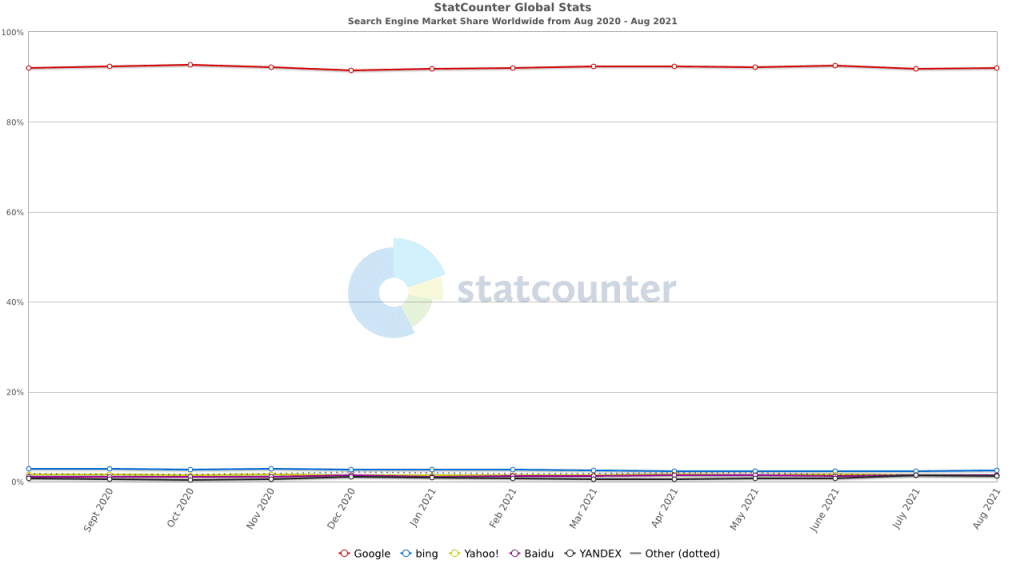
2. Effective cost control
When comparing the advertising landscape, Google Ads shines as a beacon of cost-effectiveness in stark contrast to traditional marketing channels like print ads, radio, or TV. The fundamental disparity lies in the precision of audience targeting and budget management. Traditional methods cast a wide net, reaching a broad spectrum of individuals, regardless of their affinity for your product or service. The costs associated with such broad-reaching campaigns can be exorbitant, while the return on investment (ROI) often remains disappointingly elusive. This financial burden is particularly challenging for small businesses that typically lack the substantial resources required for conventional marketing endeavors.
In the realm of Google Ads, the narrative takes a different, more cost-effective turn. Here, you wield the power to define a monthly budget that aligns seamlessly with your business objectives, without fear of overreaching financial constraints. Your ads are not merely flung into the digital ether; they are carefully tailored to reach a receptive audience, ensuring that every advertising dollar is an investment, not an expense. Moreover, Google Ads allows for daily budget adjustments, which means you can allocate more resources to days that promise higher conversion opportunities. The result is a flexible advertising strategy that adapts to real-time market fluctuations. An ingenious approach is the creation of a shared budget that can be seamlessly distributed across relevant campaigns. This approach streamlines the budget management process, necessitating changes in just one location, ensuring consistency across campaigns sharing the same budget and maintaining overall monthly spending within an impressive +/- 5% margin.
Google Ads keyword-based targeting strategy is excellent for targeting customers with specific interests. This strategy also ensures the budget is spent on relevant searches and shown to those who are specifically in the market to acquire your product or service.
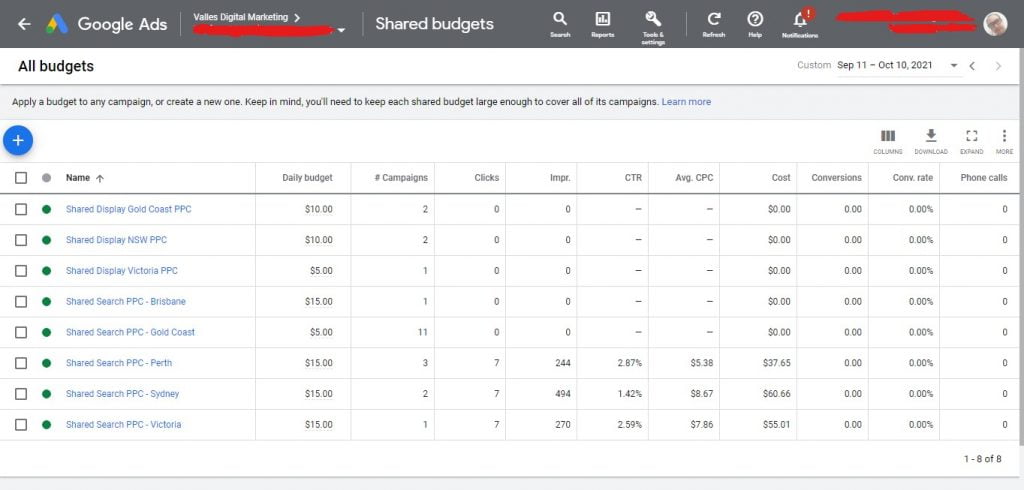
If you are concerned of going over budget, Google Ads allows you to set a spend limit. This way you will never go over budget.
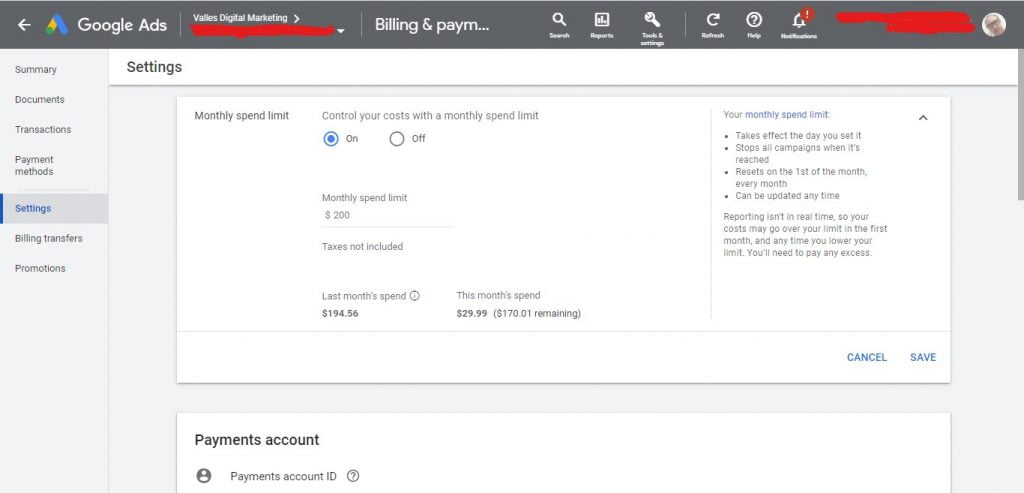
3. Keyword-based targeting
Google Ads’ keyword-based targeting lets you reach potential customers precisely when they’re searching for your products or services. This precision ensures that your budget is spent on highly relevant searches, maximizing your chances of conversion.
Unlocking the power of keyword-based targeting on Google Search stands as one of the most accessible and effective means to connect with potential customers. This strategy revolves around the art of selecting precise keywords that encapsulate the essence of your product or service, thereby directing your message to the right audience. Let’s illustrate this with an everyday scenario: imagine you find yourself in Perth, urgently needing a tow truck service to transport your vehicle from one location to another. In this moment, you instinctively turn to the trusty Google Search and input the search term ‘tow truck Perth.’ The magic unfolds as Google’s search algorithms diligently get to work, fetching results that align perfectly with your search criteria. The search results prominently feature Google Ads, which are thoughtfully tailored to match your immediate need by showcasing ads from relevant service providers.
Google Ads’ keyword-based targeting strategy is, without a doubt, a formidable asset in your marketing arsenal. This approach not only aids in precision targeting but also ensures that your advertising budget is allocated judiciously, exclusively to searches that harbor genuine intent to acquire your specific product or service. It’s the digital equivalent of catching the attention of a prospect at the precise moment when they’re poised to make a purchase decision. With keyword-based targeting, your marketing strategy evolves into an efficient, laser-focused force that engages potential customers with a heightened sense of relevancy and purpose.
This approach not only aids in precision targeting but also ensures that your advertising budget is allocated judiciously, exclusively to searches that harbor genuine intent to acquire your specific product or service. It’s the digital equivalent of catching the attention of a prospect at the precise moment when they’re poised to make a purchase decision. With keyword-based targeting, your marketing strategy evolves into an efficient, laser-focused force that engages potential customers with a heightened sense of relevancy and purpose.
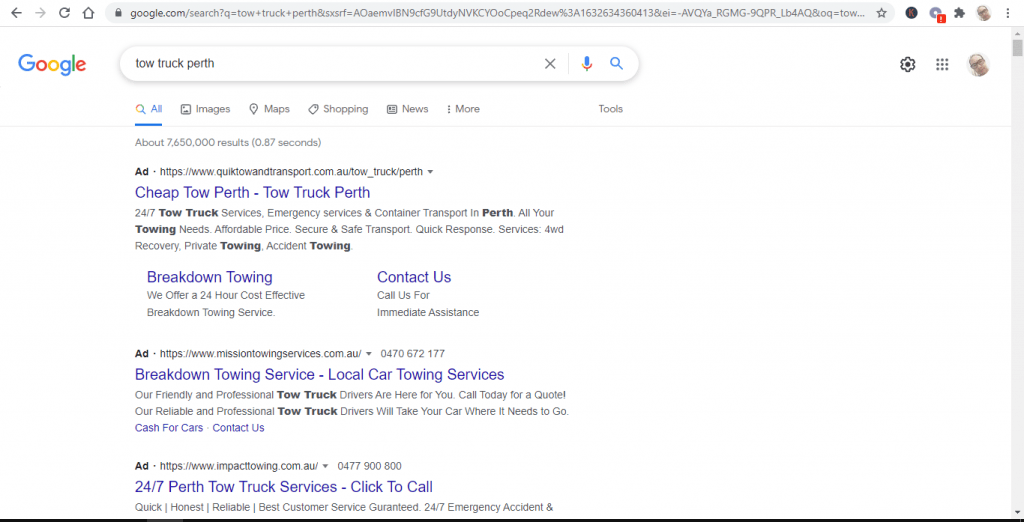
4. Geo-location targeting
Geo-location targeting is often overlooked but can be a game-changer. It allows you to reach customers based on their physical location, targeting your audience with greater precision and optimizing your campaign budget.
In Google ads, this can be either set by country or state or city. Google Ads also provides the option of using a radius setting around a certain area such as shown below.
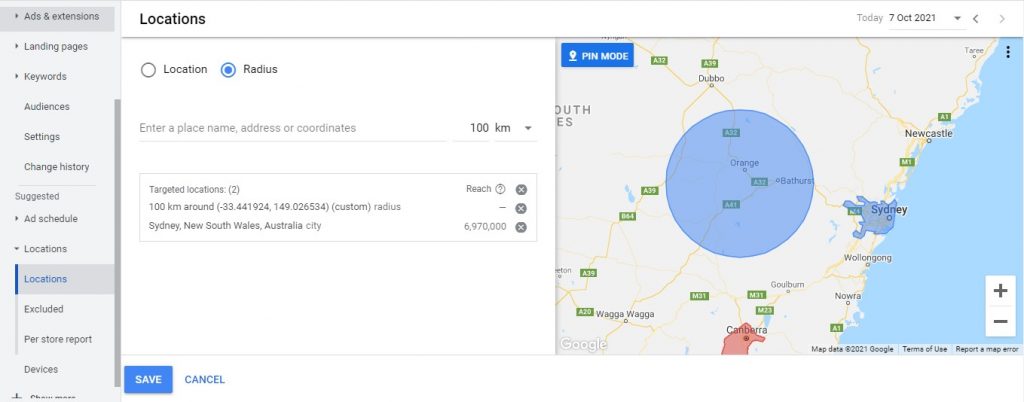
Geo-location targeting is a strategic powerhouse with a trio of paramount objectives: propelling foot traffic, amplifying sales, and heightening the quality of customer service by delivering meticulously relevant search results to individuals in a precise location. This dynamic approach enables digital marketers to orchestrate their advertising symphony with the precision of a maestro, ensuring that their audience is served with ads perfectly harmonized to their geographical context.
Beyond the salient objectives, there’s an invaluable dividend to geo-location targeting – the optimized allocation of your campaign budget. With this strategy in place, your advertising expenditure is concentrated like a laser beam on the most coveted customer segments residing within your specific target location. The beauty of this precision lies in its ability to spare your budget from unnecessary squandering on prospects who fall outside your target audience. By avoiding ad spend wastage, geo-location targeting affords your campaigns the fiscal discipline they need to yield remarkable ROI and conversion rates. It’s the fine art of smart budget management, making every dollar you invest in advertising a calculated step towards success.
5. Ad copy control
With complete control over ad copy, you can craft compelling headlines, descriptions, and keywords to capture your audience’s attention. A well-optimized ad with clear benefits can significantly enhance your click-through rate and conversions.
Google Ads empowers advertisers with a formidable arsenal for crafting compelling ad copy that is bound to captivate their audience. It’s not just about putting words on a digital canvas; it’s about creating a symphony of persuasion. In this virtuoso performance, headlines take center stage – concise, impactful, and highly descriptive. Their mission is to kindle the sparks of curiosity and ignite interest in your product or service. Each word in the headline must count, inviting users to explore further.
Complementing the headline’s tantalizing introduction is the description – a canvas where the benefits for your customers unfurl in crystal clarity. This is your chance to communicate precisely what awaits those who click on your ad. Every detail is meticulously honed to serve as a beacon of information, guiding potential customers through their journey. Moreover, it’s not just about words; it’s about keywords. Keywords used in both the headlines and descriptions should be meticulously chosen to establish an unwavering connection with individuals actively seeking products or services akin to what you offer. This strategic alignment ensures that your ad appears like a shining beacon, directing users to your virtual doorstep. Every element, from the description down to the URL, plays a pivotal role in your ad’s performance, demanding perfection.
This extraordinary degree of control is indispensable to advertisers seeking to fine-tune their campaigns for optimal ranking results. It’s the meticulous craftsmanship of each ad component that dictates its resonance with the audience, ensuring that every ad dollar spent serves as a catalyst for driving conversions and success.
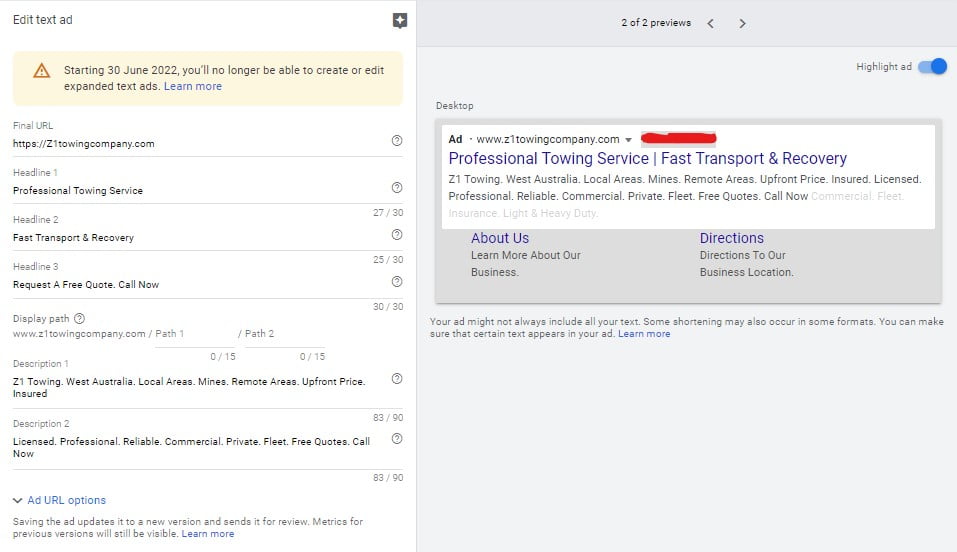
6. Landing page metrics
Landing pages are the webpages visitors land on after clicking on a link from a search engine like Google Search. Websites and single standalone webpages are considered landing pages. A website is just a more detailed elaborate landing page with navigation menus serving up different webpages for the website. If visitors can’t find what they are looking for or if they don’t like what they see, many will bounce off the landing page and never return to the site. Integrating Google Analytics with your Google Ads campaigns offers a wealth of data to analyze landing page performance. Metrics like bounce rate, session duration, and percentage of new sessions help fine-tune your landing pages for better results.
Google Analytics is the most commonly used website analysis tool for understanding website visitor behavior. It provides comprehensive insights about visitors, goals and conversions. Through Google Analytics, advertisers can measure how long visitors stay on their landing pages and analyse the bounce rate (i.e. it is the percentage of visitors who enter the site and then leave (“bounce”) without doing anything).
By linking Google Analytics to Google Ads, advertisers can track traffic from paid ads. Advertisers can then figure out which landing pages are most effective with which audiences respond to positively by submitted leads and can optimize accordingly.
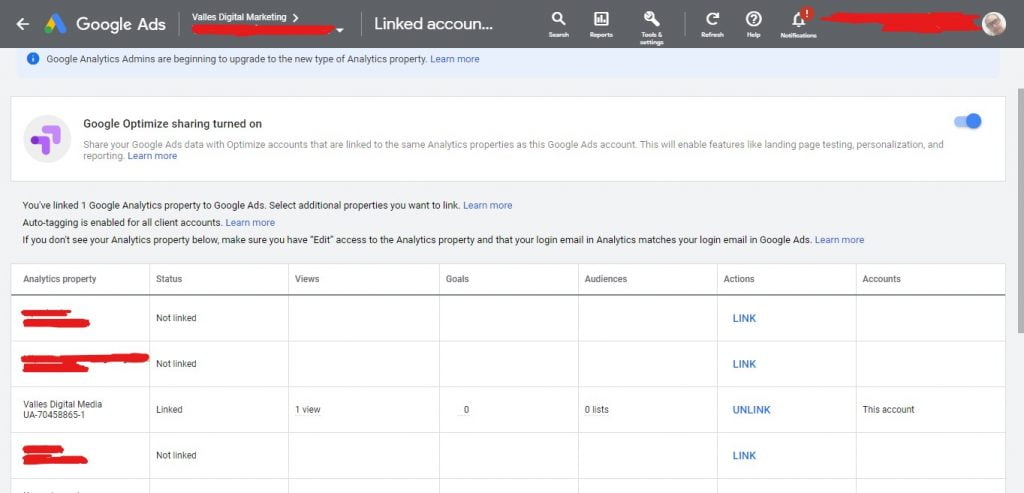
Linking your Google Analytics to your Google Ads campaigns unlocks a treasure trove of invaluable data insights that can significantly bolster your campaign’s performance. Among these insights, three key metrics take the spotlight: landing page bounce rate, percentage of new sessions, and average session duration.
The landing page bounce rate acts as a litmus test for the landing page’s efficacy. A high bounce rate or a brief average session duration can be telling indicators that the page may not be optimally tailored for the specific audience segment it’s meant to engage. These metrics provide a compelling narrative, revealing whether visitors are finding what they seek or quickly losing interest. On the flip side, a low bounce rate and a lengthy average session duration signal an optimized landing page that seamlessly resonates with the target audience, holding their attention and guiding them deeper into the user journey.
The percentage of new sessions is a vital gauge of fresh visitor influx. It illustrates the proportion of new visitors arriving at the landing page. This metric provides valuable insights into the landing page’s ability to attract and engage a constantly evolving audience, potentially opening the doors to expanding your customer base. In essence, these Google Analytics metrics, when harnessed effectively, unveil the narrative of user engagement, guiding you to optimize your landing page for superior campaign performance.
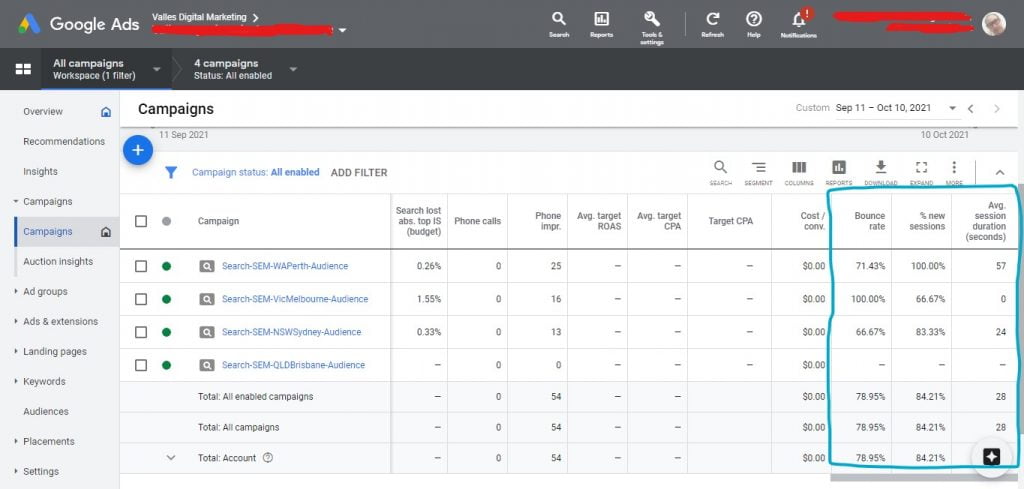
7. Monitor and optimise
Google Ads provides a range of metrics to track and analyze campaign performance, including clicks, click-through rates, impressions, costs, and conversions. Regular monitoring allows you to optimize your campaigns to achieve the best results.
Google Ads offers a plethora of different metrics to analyze. Apart from bounce rates, average session duration and percentage of new sessions, advertisers should analyse these metrics as well:
- Clicks (Sum of clicks on the ad.)
- Click-Through-Rate (CTR) (Measures how often people click your ad after it’s shown to them, which can help you understand the effectiveness of your ad.)
- Impressions (An impression is counted each time your ad is shown, which tells you how often your ad is shown. The aim is for high impressions.)
- Cost (Cost is the sum of campaign spend during the reporting period.)
- Average Cost (Average cost is the average amount that an advertiser paid per interaction.)
- Average Cost-Per-Click (CPC) (Average cost-per-click is the amount that was paid for the ad divided by its total clicks, this tells how much is being paid on each click. The aim is to maximise impressions and clicks with the lowest CPCs.)
- Conversions (Shows the number of conversions or lead submissions received after ad interactions.)
- Cost per conversion (Shows the average cost of a conversion i.e. cost divided by conversions.)
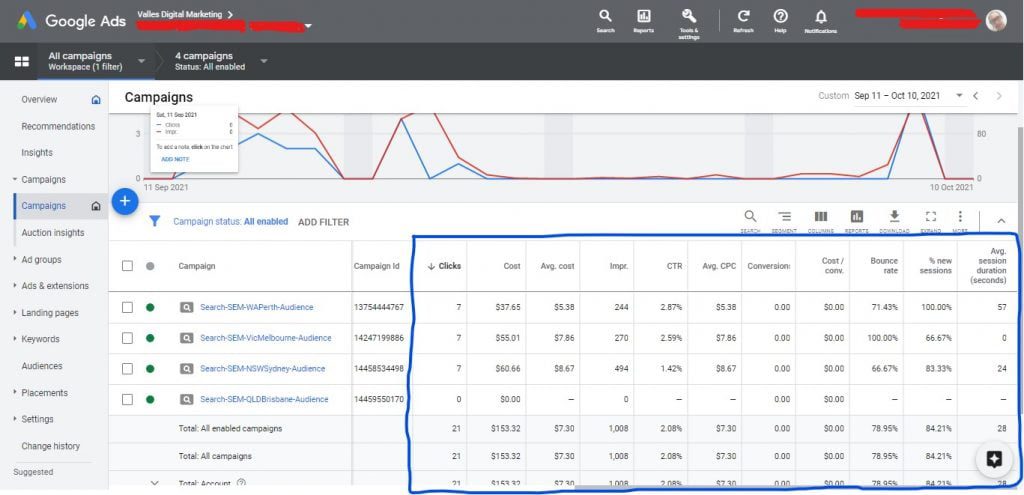
New Reasons to Choose Google Ads
Now, let’s introduce three new compelling reasons why Google Ads is an essential tool for businesses of all sizes:
8. Dynamic Ad Extensions
Google Ads introduces a groundbreaking feature that’s set to transform your advertising strategy: dynamic ad extensions. These innovative extensions have the ability to automatically showcase supplementary information, meticulously fine-tuned according to the user’s behavior and intent. This dynamic approach doesn’t just enhance the relevance of your ads; it’s a strategic marvel that creates a more engaging and captivating ad experience for your audience, while concurrently catapulting your ad’s visibility to new heights.
This groundbreaking feature heralds a seismic shift in the way your ads interact with users. No longer static, they adapt and evolve based on the individual’s online journey. For instance, if a user is exploring a range of products on your e-commerce site, dynamic ad extensions may spotlight your best-selling items, special promotions, or even highlight product reviews to bolster their purchasing decision. It’s a personalized touch that resonates with users, making them feel like your brand understands their unique needs. This level of interaction can significantly boost user engagement, making your ad not just a message but a valuable resource tailored to each user. The result? More compelling ads, happier users, and an ad campaign that truly stands out in a crowded digital landscape.
9. AI-Powered Targeting
Embrace the full potential of Google’s cutting-edge artificial intelligence to supercharge your targeting strategies. With the ever-evolving landscape of digital advertising, Google Ads emerges as the ultimate ally. It empowers you with the capability to delve deep into user data and behavior, unearthing insights that go beyond the surface level. This profound analysis furnishes you with a treasure trove of audience segments, meticulously crafted to home in on individuals who are not just interested but highly likely to convert. This transformative approach not only injects a new level of efficiency into your campaigns but also ushers in a profound era of cost-effectiveness.
The dynamic synergy between Google’s AI and your advertising strategy manifests in the form of hyper-personalized campaigns. It’s akin to having a virtual assistant that can decode the intricate web of user preferences and behaviors, deciphering patterns that might have eluded human observation. Armed with this in-depth knowledge, you can fine-tune your targeting strategies to create laser-focused ads that resonate with users on a profound level. This kind of precision doesn’t just save ad spend; it ensures that every dollar invested yields a remarkable ROI. With Google Ads and its AI-powered insights, you’re not merely advertising; you’re forging meaningful connections with your audience, delivering exactly what they seek, and achieving a level of efficiency that redefines the digital advertising game.
10. Enhanced Local Services Ads
Google Ads extends a vital lifeline to brick-and-mortar businesses with its groundbreaking feature: enhanced local services ads. This innovation has the power to seamlessly bridge the gap between you and local customers, facilitating swift and effortless connections. In a digital realm teeming with options, these ads serve as beacons of accessibility and information, providing crucial details that guide potential customers to your doorstep with ease. From pivotal information like business hours and service areas to the invaluable insights encapsulated in customer reviews, these ads constitute a comprehensive resource that simplifies the decision-making process for your audience, increasing the likelihood of them choosing your services over the competition.
In an era where convenience reigns supreme, enhanced local services ads set you on the path to be the first choice for local customers. With a quick glance, they can discern your operating hours, grasp the scope of your service area, and gain confidence through authentic customer feedback. This level of transparency and accessibility isn’t just an enhancement; it’s a beacon of trust and convenience that significantly boosts your local appeal. In essence, these ads become the digital handshake, the welcoming sign, and the treasure trove of information that guides local customers to your business, ensuring they choose you with confidence.
Summary
In conclusion, Google Ads remains an indispensable asset for businesses, offering a multitude of benefits that extend beyond traditional advertising methods. With search intent focus, cost control, precise targeting, ad copy control, landing page optimization, and continuous monitoring, Google Ads is already a powerful tool. The introduction of dynamic ad extensions, AI-powered targeting, and enhanced local services ads further solidify its position as a must-have for businesses of all sizes. Embrace Google Ads and propel your business towards greater success in the digital landscape.
If you are looking to understand the components of a digital marketing strategy, feel free to read this blog.
We also have a Google Ads case study which you can view first hand how effective Google Ads is in lead generation.
Discover how out Google Adwords Perth agency can help boost your business lead generation. Book a free 30 min discovery session now.


I am not sure where you’re getting your information, but great topic. I needs to spend some time learning much more or understanding more. Thanks for great information I was looking for this info for my mission.
Hope it was useful